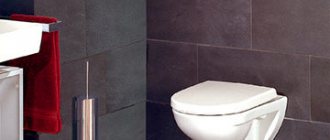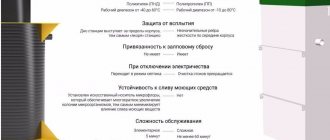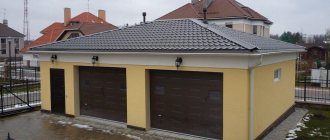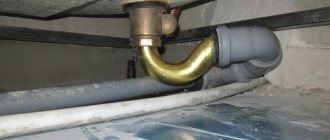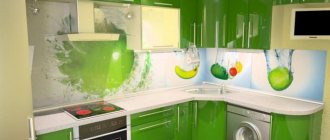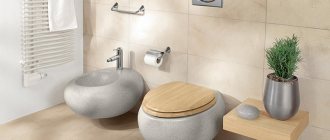Floor-standing toilets are attached to the floor, while the cistern remains outside. This is a classic, familiar design, easy to maintain and operate. It can be collapsible, when the tank is separately attached to the bowl, or monolithic.
Wall-hung ones (ROCA, KERAMAG, IFO, GROHE) are attached to the wall using an installation; the cistern is hidden behind a partition. This toilet has no leg, and it seems as if it is floating in the air. Modern hanging devices are popular in interiors designed in the style of minimalism, modern, contemporary, and hi-tech.
A few questions about the wall-hung toilet
And not to mention the fact that cleaning a bathroom equipped with a wall-hung toilet will become much easier.
But many potential buyers continue to worry about the maximum load on a wall-hung toilet.
People believe that people with a decent weight are almost forbidden to use such a toilet - there will be trouble. But all of these are, in fact, just myths. A high-quality wall-hung toilet can withstand loads of up to 400 kg. You probably don't have many friends who have at least half this weight.
Problems that may arise with a wall-hung toilet lie in improper installation of the installation. The design of the frame on which the toilet is hung is simple. Essentially, the bowl is held in place by two pins mounted into the frame. Each of them can withstand a weight of 200 kg. The frame itself is attached at four points, two of which are on the wall, and two more in the floor. If the installation system is secured professionally, according to all the rules, then nothing will happen to the toilet. Accordingly, all concerns about excessive load on the wall-hung toilet are not justified, provided that the structure is installed correctly.
Material prepared 12/19/2014
Return to list
How much weight can the toilet support? Is it possible to stand on the toilet (small work on the ceiling above the toilet)?
Is it necessary to locally repair the ceiling above the toilet? How much weight can the toilet support and is it possible to stand on it?
Toilets (floor compact) are manufactured strictly in accordance with GOST.
In the technical characteristics of the toilet there is also such an indicator (parameter) as the maximum possible load on the toilet.
If we are talking about a floor-standing toilet, then this is 200 kg and no more.
This is quite enough, because the operating conditions of the toilet do not allow the full weight of a person to load it, feet on the floor, in other words.
But it is important to consider that there may be microcracks in the toilet that are not visible during visual inspection, but there are no leaks.
From personal experience I can add, I changed the customer’s toilet at my own expense, the reason was the same microcrack, I stood on the toilet, it “scattered” under me, my weight was 100 kg (+-), that is, the load was 2 times less than the permissible one.
I don’t recommend standing on the toilet; in addition to microcracks, there is a load of a different effect, of a different direction.
If you really need to, then cut a piece of thick plywood, or MDF, chipboard, slightly larger than the size of the toilet bowl, open the lid (you absolutely cannot stand on it) and lay down the plywood.
In this case, the load will be uniform and not point-like on the edges of the toilet.
It’s even better to look for other options, the toilet may not crack (bowl), the platform in the area of the fastening bolts will crack due to lateral load
Especially if the bolts are not properly tightened and there is play, or you “forgot” to install plastic bushings between the bolts and the toilet
The shaft of the metal bolt is in contact with the earthenware and this is a “dangerous” contact.
A construction stepladder stands quite normally above the toilet, with its legs on the sides resting on the floor. If you have one, then it is certainly better not to expose the toilet itself to such influences.
Floor-standing toilets must withstand a breaking pressure of at least 300 kilograms . Wall-hung toilets can withstand at least 150 kilograms , although their installation can withstand up to 400 kilograms , because some frame installations are made very massively.
If there is no other way out, you can stand on the toilet without swinging on it and distributing the pressure as evenly as possible along the entire perimeter. It goes without saying that you should not stand on the stationary plastic toilet lid, which is designed to simply cover the sink and protect it from odors and foreign objects. You should use a wide wooden surface (metal can scratch the enamel). You can put a piece of unplaned board 40-50 millimeters thick and at least 200 millimeters wide. On the bottom side of the board, nail blocks along the width of the toilet, and on the inside so that the board does not “crawl” on the sink. When performing work on such a stand, you should exercise maximum caution and attentiveness, because adapted stands always have a risk of injury. A small table that can support your weight, placed on top of the toilet and resting on the floor, will be more reliable than standing on the toilet itself.
What to look for when choosing
Installations under the toilet are sold both complete with the bowl and separately. It’s easier, of course, to buy everything in a set. Then all sizes will exactly match. If you already have a bowl, you will need to look at the dimensions of the frame and the distance between the fasteners - it should coincide with the mounting holes in the toilet.
It is very useful if the frame has the ability to be adjusted in height - you can set the bowl to the level you need
Pay attention also to the type of painting. The best option is powder coating
It is reliable, creates a tough, durable film that adheres well to metal. All other types of paint hold up worse.
Installation dimensions Grohe Rapid Sl (Germany)
When choosing an installation for a toilet, you should pay attention to the equipment. Usually, fastening elements come along with the frame - for hanging the toilet, fittings for fixing sewer and water pipes
Some companies also include a tank and a drain button as standard. The drain, by the way, can be dual-mode. It is more economical, since when you press the large button, 6-9 liters are drained, and the small button - only 3-4 liters of water. It’s good if the drain is adjustable - the volume of flushed water can be adjusted to the specific shape of the toilet.
Which type is better?
Which type of installation for toilet and bidet is better? The frame structure is considered more reliable - it usually uses thicker metal, but it also costs more
In any case, when choosing a frame for a wall-hung toilet, pay attention to the strength of the structure - it should not wobble, its elements should not sag. Inspect the welds and the quality of the paint - there should not be even small flaws
And a little about the manufacturers. The best toilet installations are those made in Germany and Italy. But their plumbing is expensive. The quality of equipment for bathrooms and toilets is made in the Czech Republic and Bulgaria, and the price range for their products is average. The cheapest installations and wall-hung toilets are Chinese, but dealing with them is risky - they can work fine, or they can quickly fail.
Wealth of choice
Oval, round, rectangular - whatever shapes designers can come up with for wall-hung toilets. In order to roughly imagine the variety of models, you need to multiply the number of shapes by the number of colors and shades, but there are also toilets with drawings. In addition, toilets are available in different sizes, there are even small children's models.
Or another direction for expanding the range - high-tech new items. A toilet with a built-in bidet is already a thing of the past. Nowadays there are often models with built-in thermometers and clocks. And for wealthy clients, special computer programs will indicate the presence of protein in the urine or something else like that.
How to choose an installation for a toilet
Design
First of all, you need to get acquainted with the design of the suspension system. Almost all models are attached to the back wall; it is this aspect that is important to pay attention to. Some models do not have support on the floor due to the lack of legs (block system). Such installations are not recommended for heavy people, and the strength of the wall should not be in doubt.
Installation. To avoid installation difficulties, you should take into account the features of the communications supply
On sale you can find standard designs that are suitable for apartments and most houses. Integrated systems are designed for office buildings, retail facilities, industrial premises, etc. Toilets can be located either side by side or on opposite sides of the same wall.
Service. You should not make your final choice based on the aesthetics of the controls. It is necessary to make sure that the plumbing units can be serviced through the service window.
Buttons. The drain button often becomes a deterrent when purchasing. Dual-mode systems have already been replaced by contactless models, as well as “flush-stop” designs. Contactless buttons look stylish and modern, but the traditional dual-mode option has maximum reliability.
Price. You can save a lot of money when purchasing a complete installation. The standard set includes a supporting frame, a drain tank, controls, sound insulation, adapters and fasteners.
Reviews. A lot of useful information about the performance of the installation can be found on thematic forums. This is where system problems in a particular model are most often identified.
Monoblock
The production of monoblocks has become a real alternative to installation due to a number of advantages that compact toilets do not have:
- simple equipment - solid cast toilet;
- ergonomic shape of the bowl - it is comfortable for any family member to sit, even with disabilities;
- smaller linear dimensions, which is why it requires less space than a classic “compact” toilet;
- easy maintenance – the absence of a “dead zone” makes cleaning the bathroom easier;
- easy installation;
- the presence of a microlift - the lid lowers smoothly and silently;
- some models are available as a shower toilet (this feature also appeared on compact toilets);
- no leaks at the drain tank;
- efficiency - most models use several drain modes.
The disadvantages include:
- higher price compared to compact models;
- the inability to repair the tank drain system (theoretically, it is possible to replace a failed element, but in practice it is extremely difficult) - only a complete replacement of the fittings, which is quite expensive.
Advantages and disadvantages of wall-hung toilets
There are a number of advantages over floor-mounted toilets, here they are.
- 1. Not only do wall-hung toilets fit into any interior, but the variety of colors and shapes plays an important role in this. They can create a completely unusual interior by hanging the toilet in the corner. This is impossible to do with a simple toilet.
- 2. The tank is located behind the wall, that is, it does not take up space
- 3. Any pattern can be laid with tiles on the floor of the toilet room, since there is no toilet sticking out and getting in the way.
- 4. A lot of space is saved in the bathroom.
- 5. There are no difficulties when cleaning (even in the most inconvenient place - behind the toilet).
- 6. The design can withstand any imaginable human weight.
There are also disadvantages, but they do not relate to the functionality of the design.
- — the price is much higher than that of a floor-standing one.
- — it’s almost impossible to make the markings yourself accurately, insert bolts and studs, you need to call professionals.
All this splendor began three decades ago in the USA (pragmatic Americans tried to install as many “seats” as possible in the toilets of public institutions). Now manufacturers from different countries produce wall-hung toilets and installations for them, including in the post-Soviet space. But, if you need a really high-quality model, then you need to take a German or Italian one, since these are real brands.
pros
A wall-hung toilet is already the result of the development of modern technologies in the field of plumbing. Such products allowed us to solve many problems, as well as implement a number of new design ideas. That’s why they are found mainly in apartments and houses of young couples, those who keep up with the times and want to combine new trends with practicality.
The main advantages include:
- The cleaning process is simplified, since after installing the plumbing fixtures, you don’t have to struggle to reach corners and hard-to-reach places with a rag in order to wash the floor there;
- The floor can be heated if necessary;
- There is no need to violate the integrity of the floor tiles;
- Communications and even the tank are hidden behind the wall, so the room takes on a more aesthetic and pleasant appearance;
- The product can withstand a lot of weight, despite the apparent airiness of the plumbing fixtures.
Common Myths
Myth No. 1.
The structure is not able to support a person, especially an obese one - it will simply fall apart under him. Because of this, overweight people should not use a wall-hung toilet all the time.
Any installation can withstand up to 400 kg
Refutation. Reliability is guaranteed by a frame made of steel. In addition, it is attached to the wall, which will prevent the structure from collapsing. Plumbing manufacturers claim that such a toilet can easily withstand a weight of 200 to 400 kg. And some vouch for 800 kg. Even ordinary floor hygiene products do not have such parameters.
Myth No. 2.
Since the entire mechanism is hidden inside the installation, in case of repair or replacement of any element, you will need to break the wall.
Refutation. Manufacturers specially make the built-in tank from heavy-duty plastic. It lasts a very long time, and most likely there will be no need to replace it throughout the entire life of the toilet. Repairs can only be required by the flush itself, and it is easy to access by removing the panel with the flush button. Having turned off the water, you can take out the “filling” - a mechanism with a float, a shut-off valve - and, if necessary, adjust or replace them.
Access to the drain system
Also, the tap itself, with the help of which the water supply is stopped, is not designed quite normally. It has an atypical thread, and it is attached using a plastic part that is easy to unscrew. In the event of a malfunction, the tap can be removed or even left open. In such a situation, the water is shut off from the outside.
Myth No. 3.
If something breaks, it will be extremely difficult to get the right part.
Refutation. The units are initially equipped with everything necessary. For them, as for other models, a wide variety of spare parts are available for sale. In addition, the buyer chooses the button for the tank himself. Therefore, he can ask in advance how difficult it will be to get its analogue.
Myth No. 4.
Installation requires a lot of space, because you still need to build a false wall, and it takes up additional centimeters of space.
The system is quite reliable and rarely needs repairs
Refutation. A hanging hygiene item, unlike a floor-standing one, is located close to the wall. The space that the tank usually occupies is reserved for installation. If you install it in, you can even save a little space.
Myth No. 5.
They cost more than any others. Refutation. If you compare inexpensive models of conventional hygiene products and designs with installations, the advantage will certainly be with the former. However, if we are talking about toilets of the same quality, then both wall-hung and floor-mounted ones are approximately in the same price category. Most of all, the cost is influenced by the installation itself. It can be purchased separately. And often clients of plumbing stores choose a toilet from one manufacturer and an installation from another. Therefore, the final cost of the complete set depends on the personal preferences of each buyer.
Choosing a flush cistern
All manufacturers make the flush tank from plastic; it can consist of one or two parts (one-piece or prefabricated). Inside it there are plumbing fittings that provide automatic filling and flushing. You shouldn’t pay much attention to its appearance: it will still be hidden from view.
Product quality and functionality are important:
In our installations, the tank is made of a single piece of polyethylene; it cannot be broken even with a sledgehammer. There are no metal parts inside the tank that come into contact with water, and this guarantees the absence of corrosion.
The drain tank often becomes a subject of concern for people who dream of installing an installation, but are afraid of leaks. As our expert says, they are afraid in vain.
Our tanks have no seams, and the drain mechanisms are equipped with an emergency overflow with a siphon effect. It drains water into the sewer even at maximum operating water pressure before filling.
There are models of installations without a tank - the water for flushing comes directly from the pipes. The depth of such installations is less, but flushing will always depend on the water pressure in the water supply system. And at the same time, pressure fluctuations in the cold water supply system can cause discomfort and even burns if someone is using a shower.
Design Features
Having seen a wall-hung toilet, a rare visitor to a plumbing store will not be puzzled by the question: how does the structure hold up, what ensures its strength? After all, the toilet bowl does not have the usual foot. Fastenings that guarantee reliability are also not visible on the surface.
Wall-hung toilet
The installation provides stability - a massive steel frame, which is often sold separately from the toilet. It can be attached only to the wall or additionally to the floor. It is covered with a plasterboard false wall on top, and the illusion is created that the plumbing fixture is really not supported by anything.
Since the cistern, along with all communications, is hidden behind plasterboard, most often the structure is located in the niche of the bathroom, where the water supply and pipes are located. If you choose another location, keep in mind that you will still need to make a 20-25 cm recess in the wall to accommodate the tank. It has 4 mounting points, 2 of them on the floor, which allows you to set the desired height. The tank itself is made of plastic, not ceramic, like a regular one. It can be accessed through a panel with a button located above the bowl. Through it you can turn off the water or make minor repairs.
Installation of several installations in the bathroom
The bowl of such a toilet is the only thing that is visible from the entire structure, so its selection must be approached especially carefully. Design developments allow you to choose:
- color - from classic white to acidic or rainbow shades;
- shape - from round and oval to rectangular and other, more complex modifications;
- materials - from ceramics and steel to plastic, polymer concrete and glass.
Advice. From a practical point of view, plastic is not very convenient: it scratches easily. Polymer concrete does not accept cleaning with all means. When choosing between earthenware and porcelain, give preference to the latter. Thanks to its smoother surface, it needs to be cleaned much less often.
PS
And one more piece of advice: often plumbers, without even asking clients, independently choose the installation to install based on their own interests. It’s good when a plumber installs high-quality installations. But very often the opposite happens.
More about the kits
As you can see, there are quite a lot of nuances in choosing high-quality and durable plumbing fixtures. Therefore, regarding the selection and correct choice of plumbing products, we recommend contacting our Von Tann salons.
. Here you can get professional advice, see toilet installations in action, touch, feel and make an informed and correct choice.
Minsk, Dzerzhinsky Ave., 9
+375 (29) 372-20-05, +375 (17) 394-99-49
Minsk, Pobediteley Ave., 65 in the shopping center Castle HOME, pav. 420
+375 (17) 224-24-80, +375 (29) 676-73-78
Gomel, Lenin Ave., 14
+375 (23) 231-99-06, +375 (29) 696-90-85
Installation of a wall-hung toilet
In another way it is also called installation. Also called installation is the entire mounting structure for wall-hung toilets. It is very simple, but this does not make it any less reliable. The fasteners themselves are few in number, but they are powerful.
The design consists of a steel frame on which a drain tank is mounted. Since the sizes of toilet rooms differ from each other in houses of different layouts, retractable rods are provided in the frame to facilitate installation. It is easiest to mount such a toilet in a wall or in a niche in the wall, then the frame can be lightweight, in other cases it should be stronger and more massive, but even such a bulky structure is covered with a panel or laid with tiles. The structure is attached only to main walls; partitions are not suitable for this. The drain tank is made of special polyethylene, durable and does not collect condensation from the outside. It turns out that the tank has 4 mounting points. Two of them are the legs of the structure and are attached to the floor. They regulate the height of the tank. And it should be placed so that the tee of the sewer riser is connected to the drain hole of the tank. And only after they are adjusted and connected, the tank is attached to the wall. Next, panels are installed: it can be made of plasterboard, it can be made of other materials that can even be covered with tiles (but this will add work to making holes in the tiles so that the toilet bowl can be secured).
The toilet itself is attached to the tank via adapters included in the kit. Having screwed the toilet to the wall with nuts, you need to connect two cables located inside the tank to the flush button (for the large and for the small flush). Installation is completed by snapping the drain button into place. That is, no cisterns or steel structures will be visible, the toilet will seem to come out of the wall.
Reinforcement: invisible but important components
Fittings are attached to the installation: tank, pipes and other parts.
Despite the fact that some parts are hidden behind the false panel, they are also important for the long, reliable service of the wall-hung toilet
All components must be made of especially durable polymers or metal with an anti-corrosion coating. The button can be connected to the sewer fittings using a pneumatic device, a lever or a cable, with preference given to the first two mechanical methods.
Image gallery
Photo from
Drainage cisterns are part of the installation
Cisterns fittings for hidden installation
Covering a false installation with a plasterboard wall
Technological hatch for equipment maintenance
Is a toilet attached to the wall secure?
Absolutely yes. It's all about the mounting frame. If the wall is solid, then the tank can be attached directly to it. If you need to attach it to a partition or drywall with fragile tiles, then the tank is attached to the frame, and the frame is attached to the floor, transferring most of the force to it. Therefore, if the toilet itself has no defects and does not fall apart due to any microcrack, nothing threatens the user of this delicate device, because the toilet bowl is suspended on pins screwed into the installation (that is, into this frame structure). Calculations give the following figures: the weight of the user of a wall-hung toilet can be about 200 kilograms, maximum 400 kilograms. You will probably never meet such giants in your entire life.
There should be no fear of breakage of that part of the equipment that is hidden in the wall: there is nothing to break there except the drain. And it is easily accessible through the hole under the drain button.
Real reviews from owners
- If you install the toilet below or above 40 cm from the floor, this will cause inconvenience to some family members. To prevent this from happening, you need to clearly discuss the installation process with specialists.
- With a wall-hung model, the bathroom is transformed. The toilet no longer takes up space in the center, looks modest and stylish, and makes the room visually larger.
The toilet takes up minimal space in the bathroom - It’s very convenient to clean, you don’t need to wash “behind the toilet,” and you can lay the same tiles throughout the entire bathroom without adjusting to the hygiene items on the floor.
- Installation is usually the most expensive part of a purchase. But you shouldn’t skimp on it either, because it ensures the reliability and safety of the structure. If you have a limited budget, it is better to choose a cheaper bowl. Also, when buying a toilet, it is important to immediately include the cost of installation as an expense item.

